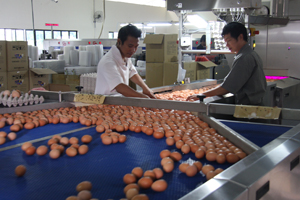Egg enrichment for health and marketing

Enrichment is a strategy appropriate to industrialised countries where there is a demographic willing to pay a premium for an added-value product. In developing countries, supplementing eggs to compensate for nutrient deficiencies may be a viable strategy if supported by a national health agency.
By Dr Simon M. Shane, Durham, NC USA
Studies as far back as 1934 demonstrated that it is possible to modify the nutrient content of shell eggs. The range of compounds that can be increased by manipulation or supplementation of the diets of hens is shown in Table 1. There are two principal motivations to adjust nutrient content of eggs by incorporating specific ingredients or additives into the diet of hens. The first is to increase the contribution of eggs to dietary needs especially where nutrient deficiencies occur. The second and more extensive application involves the production of branded, nutritionally enriched eggs which sell at a premium against generics.
It has been demonstrated that in areas such as Eastern Europe where natural foods are deficient in selenium that consumption of one selenium-enriched egg can satisfy daily needs. This mass application is analogous to adding iodine to salt or folic acid and niacin to wheat to prevent nutrient deficiencies. This approach is appropriate for developing countries and is usually associated with a government programme incorporating compensation to producers for the additional small cost involved.
The major motivation for enrichment is to differentiate added-value eggs from generics. Producers select from the nutrients listed in Table 1 and can match nutritional formulation to market demand. This is generally driven by dieticians and healthcare professionals promoting the benefits of specific nutrients.
Enrichment can substantially contribute to the profitability of a producer. A good example is Cal-Maine Foods Inc., the largest egg producer in the world with over 32 million hens. During the third quarter of fiscal year 2013, specialty egg sales, including enriched products, represented 16.7% of their sales volume, but 23.6% of sales value. The average unit value of branded eggs was calculated to be US$1.98 per dozen compared to commodity eggs at US$1.29 per dozen. Although the cost of producing enriched branded eggs is higher than conventional eggs, the strategy of enrichment should result in an incremental margin.
The need for branding
It is self-evident that to enrich an egg incurs incremental costs of feeding which must be recouped by a higher selling price. Branding is critical to developing a programme to increase the consumption of enriched eggs. A brand defines and identifies a product and imparts differentiation from generics and competitors’ products. Branding is an ancient concept. Wine flagons unearthed in Pompeii dating from the first century bore the Vesurinum Brand identifying the vintner. The elements that can be applied to shell eggs include a brand name, a logo for ready identification, a catch phrase encompassing the marketing strategy, graphics supporting the name and logo, a list of attributes which generally include enrichment. Consumer interaction through advertising, websites and the social media support programmes of branding.
In the US, 6.7 billion dozen eggs were produced in 2012. Of these, 69% were marketed in shell form with 1.5% exported. It is estimated that 86% of the 4.7 billion dozen shell eggs marketed in the US are non-branded commodity product. Currently 11% of eggs are branded, but not necessarily enriched by a producer and 3% of branded eggs represent store brands promoted by a specific supermarket chain. These store brands also referred to as private label or “house brands” are usually discounted against national brands.
Enrichment of eggs in the US and Canada is based on dietary additives and label claims which are subject to the approval of the USDA Agricultural Marketing Services and the Canadian equivalent. In the US claims relate to required daily allowances (RDAs) which are published by the Food and Drug Administration (FDA). It is emphasised that health claims are strictly controlled and fall under the FDA, the USDA and the Federal Trade Commission. Table 2 lists the nutritional attributes of products which are available as conventional white shell eggs and cage-free brown products. US Department of Agriculture Certified Organic eggs are produced in accordance with the rules of the National Organic Program and may or may not be enriched.
Technical aspects of enrichment
It is possible to alter the fatty acid composition of eggs by incorporating specific ingredients in diets. Compared to conventional eggs with approximately 40 mg of omega-3 fatty acids, mainly in the form of ALA, US enriched eggs contain 100 to 250 mg of omega-3 fatty acids of which approximately 25% comprises DHA and EPA with the remainder ALA. The omega-3 fatty acid content can be increased by incorporating canola oil, flaxseed, algae extracts or deodorised fish oil in diets. Levels of omega-3 fatty acid of up to 600 mg per egg can be achieved, although in certain cases, taste is adversely affected by high levels of fish oil or flaxseed. The fatty acid composition of eggs can also be altered by reducing saturated fat. Deletion of animal fats in diets will lower the saturated fat content. It is possible to reduce saturated fat of generic eggs by 25%.
Despite frequent claims to the contrary, it has not been possible to reduce the cholesterol content of eggs under commercial conditions for extended periods. Under experimental conditions cholesterol in eggs can be lowered by administration of statin drugs but egg production is markedly reduced, supplementation of diets with drugs is not allowed and this approach would be prohibitively expensive. Trials with herbs and “secret additives” have proven to be unsuccessful and claims that eggs contain less than the accepted 175 mg of cholesterol have not been substantiated by analysis in reputable laboratories using standard procedures of extraction and chromatography.
There are limitations as to the level of specific nutrients that can be incorporated into eggs. Generally fat soluble vitamins can be increased although the level attained plateaus and egg composition to further supplementation of diets is nonresponsive. To achieve very high levels of nutrients it is necessary to add supplements directly to egg products since inherent biological inefficiencies associated with feed conversion and transport to eggs are eliminated.
Establishing and maintaining a brand
Building a brand requires integration of production technology, sales and distribution. It is necessary to develop an effective marketing programme incorporating pricing, promotion, product characteristics and distribution. Quality assurance is critical especially when the product is derived from flocks located over a wide geographic area. For example the leading US brand is produced in 20 states with as many as 40 major production units and numerous individual farms to ensure freshness and continuity of supply. Quality assurance is incorporated in a comprehensive operations manual which outlines mandatory housing, welfare, nutrition and standards for packing. These specifications generally exceed industry standards including the mandates of the Food and Drug Administration Salmonella Egg Safety Programme.
The nutrient quality of eggs is subject to laboratory assay of both feeds and products and the company laboratory carries out in excess of 40,000 assays for nutrient content and physical and organoleptic quality each year. Optimal shell and internal quality is maintained by field audits, store reviews, and laboratory assays for both the health and quality of the flocks.
Features of the programme include positive trace back to flock of origin, individual identification of eggs which are imprinted with the brand logo. Inventory is rotated to ensure freshness and in accordance with regulations, eggs are maintained at a temperature of 7ºC from packing through to point of sale. Well-stocked shelves are critical to maintaining sales volume and satisfying the demands of loyal consumers. Establishing a brand does however create vulnerability to publicity arising from defects. A crisis can arise as a result of diseases such as avian influenza or Salmonella infection or accidental contamination of the food chain as has occurred in the EU with dioxins and PCB. Accordingly appropriate pre-emptive crisis response programmes are required to respond to possible events.













